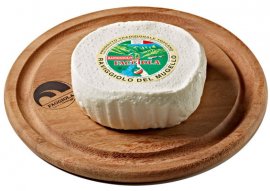The characteristics
When we refer generally to farro (spelt), we are actually talking about three particular Triticum “wheat grains in the husk”. At present, there is no Italian variety of spelt registered in the Registro Nazionale: the Italian product that can be found today actually derives from ancient “populations” (varieties) that farmers in specific geographical areas have passed down through the centuries and which, in part, have gone through a selection process.
The history
Spelt is an ancient cereal. It was first cultivated 9-10 thousand years ago. This cereal has helped man survive for generations, and has helped give rise to the first settlements (end of nomadic way of life). Its origins lie in the mountains of the Fertile Crescent, between Iran, Iraq, Syria and Palestine, where its progenitor, T.dicoccoides, grows wildly. It was brought to the Mediterranean by man some time after its domestication.
During the whole of the Neolithic and Bronze age, spelt was the principal cereal. The Romans and Greeks, as well as the Egyptians, grew spelt.
It was first grown principally in Mesopotamia, Syria, Egypt and Palestine, but later found its way to Anatolia, in the Mediterranean basin, and to Western Europe.
In our peninsula it first spread, through Greek colonization, in southern Italy and was the basis of the Ancient Roman diet. The Romans used farina (flour from the word farro) to prepare a sort of mush called “farratum”.
During the Roman Empire the spelt seeds, called “faro odoreum” or “odour” were protected by Cerere, the goddess of the harvest, and considered the grains of power. In that era, spelt was presented to the heroes that had distinguished themselves in battle: it was considered an honour and glory called “odorea”. The Roman doctor Galeno declared that spelt was chosen over barley for the soldiers’ diet because, even then, this cereal was considered more energy-giving and nutritional.
Spelt is a very rustic product. Being resistant to drought as well as other adverse conditions, it’s definitely an alternative for inland, hillside and mountainous cereal-growing areas.
Farm-grown spelt preserves the same characteristics as wild spelt: it doesn’t lose a part of the husk (glume and glumella) even after threshing.
The fact that the grain is in the husk is very important from an agronomic point of view (protection from pests and other environmental adversities, as well as helping the product keep longer).
Since spelt has not been genetically modified it cannot be produced in the same quantity as wheat, but in more difficult and marginal lands its rustic quality reduces this disparity.
This unsophisticated product doesn’t need chemical treatment during cultivation and this means the possibility of an organic, or at least, natural crop growing.
Where and how it is produced
For some years now in Upper Mugello - but recently also in Vicchio,in lower Mugello - in the town of Firenzuola and a part of Palazzuolo sul Senio, organic spelt is being grown. It is grown, worked and made ready for sale on the territory.
Seeds are planted in autumn using the unhusked grain. The production of this organic spelt, controlled and certified by authorized agencies that control and certify organic products, for example the Consorzio per il Controllo dei Prodotti Biologici (CCPB) in Bologna, does not employ chemical fertilizers, phito-pharmaceuticals or weed-killers. In Mugello, in Scarperia, we can also find a farm estate that produces spelt using an integrated pest management (IPM) system.
The harvest of spelt takes place in summer with the use of a normal wheat threshing machine. The spikes separate fully from the rachis during threshing but the caryopsis does not fall from the glume and glumella (this is why it is called “grain in the husk”).
The covering must then be removed through a series of processes.
First of all, the raw material, which is stocked in silos, is “drawn out”, with the help of an Archimedean screw and a bucket elevator, and moved to the work room where the grain, “in the husk”, is put through the production process.
At this point a series of alternating phases take place: sifting (which helps eliminate impurities), stripping (elimination of the husk), polishing (elimination of a part of the film that embraces the grain, which helps reduce cooking times), and, at last, packaging.
Contrary to what people may think, spelt is a quick easy meal to prepare and it does not need to be soaked. 15 minutes is all you need to make a fresh tasty salad, and in 18 minutes soup is served. Spelt can also be bought “express”: it's ready in just 2 minutes!
Spelt can be used in grains, like rice, or ground, like polenta. In fact, it is used whole in minestrone soup (1 tablespoon per person), croquettes, cold salads, and in meatballs, while spelt flour, when mixed with regular flour is also excellent for making home made pasta, bread, pizza, pies and biscuits. The pasta is ready in 6-7 minutes and can be served with simple sauces made with fish or vegetables, or simply with ricotta cheese and truffles or prosciutto strips. Some cooks consider the “amatriciana” sauce the best choice for this sort of pasta.
Spelt based foods should be served with plenty of cooked, or better yet, raw vegetables to help maintain fibres, salts and vitamins.
Phone: + 39 055 8046053
Website: www.faggiola.org
Email: info@faggiola.it
Phone: + 39 055 8402103
Website: www.palagiaccio.com
Email: commercialepalagiaccio@gmail.com
Phone: + 39 055 8490367
Website: www.centrocarnimugello.it
Email: info@centrocarnimugello.it
The Shop is open from Monday to Saturday 8.30am-1pm and 3.30pm-7.30pm, on Sunday 8.30am-12.30am
Phone: +39 055 818186
Website: www.poggiodelfarro.com
Email: info@poggiodelfarro.com
Phone: + 39 055 8101017
Email: vivoli.marcello@tiscali.it
Phone: + 39 055 8046053
Website: www.faggiola.org
Email: info@faggiola.it
Phone: + 39 055 8402103
Website: www.palagiaccio.com
Email: commercialepalagiaccio@gmail.com
Phone: +39 055 8448028
Mobile: + 39 328 4764164
Website: www.agriturismocolombaia.com
Email: galluzziclaudio@libero.it




































































